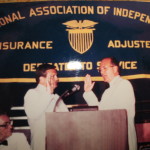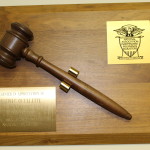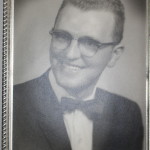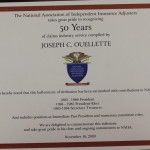Joseph C. Ouellette – 57 Years Active in NAIIA
As of November 16, 2016, Joseph C. Ouellette will have been an Independent Insurance Claims Adjuster for 57 years “and is still at it.” The following is his perception of the last 57 years in the Insurance Adjusting Industry.
Message from Joe
“My career started on November 16, 1959 employed as a trainee for M.M. Johnson Claim Service in Fort Wayne, IN.
A new employee was issued a company car “that was the perk of the employment.” We were assigned to an office, as back in those days, we all worked from an office which included being in the office on Saturday morning from 8:00am to 12:00pm, unless you had an outside appointment.
As a new adjuster, I was issued a recorder, a company credit card for gas involving company business only and before you could start work, you were required to sign a non-compete contract. You were then given a stack of closed files to review in order to get some idea as to what a claim file looked like and some instructions as to the duties the employee was to follow during the course of his investigation and the opening and closing of the file. After a few days, you were then assigned to an experienced adjuster that you would ride with for the next minimum of two weeks before going out and working on your own.
Once you were on your own, you were to report to the supervisor in the office every morning going over your activities of the prior day as to what was accomplished for the supervisor to review with detailed instructions for follow up and reporting.
Everything was well documented for each adjuster to include your gas receipt as well as the mileage on your automobile checked periodically by the supervisor compared to the time billed in the file. In regards to the office, it was staffed by the owner who was a hands-on owner, along with one or two supervisors. The clerical staff was one lady at the front desk for the purpose of handling phone calls and setting up files. The office that I was working out of had 10 adjusters and one lady would be in charge of following up on the diary system, checking diary dates on files that were due for review or report, and another lady for the accounting position.”
Adjuster Must-Haves
“In addition to your recorder, you were issued a Polaroid camera, once you were out on your own and were issued film for your camera on an as-needed basis rather than a pick and go of the film as it was documented as to how much film the adjuster was using to be sure that the film was being used for business purposes only.
In regards to the equipment, the recorders that we were issued had an approximate 8 inch cone covered with a type of plastic that when you would dictate, it would cut into the surface, and then after it was transcribed would be shaved to the next level cleaning off your previous dictation. In addition to the front office, as we called it, we had a separate office that had a staff of at least 4 or 5 ladies that would be transcribing the reports on these old cone type of equipment in a separate room. Our Polaroid pictures that were taken to be submitted with our reports would be taped unto a plain sheet of paper with either a typed or hand-written description of the image that was taken.”
Taking Statements
“In those days, there was no such thing as a recorded statement in that all statements were handwritten statements, and I cannot remember just when it was, but some years later, Liberty Mutual Insurance Company was the first company that came out with a recorded statement. Now the recorded statement was always to be taken in person, and at that time there was no such thing as a telephone recorded statement. Even after the recorded statements came into play, for the most part, companies still insisted on handwritten personal, face-to-face, statements with special instructions on how to take a valid statement.
The statement was to have no paragraphs and/or broken spaces with each page numbered. The adjuster was instructed to purposely make an error in spelling and/or an error in some comment where it would have to be crossed out and initialed by both the adjuster and the individual that you were taking the statement from. The instructions were that this was to happen on each page of the statement.
The statement was to end with these statements: “Have you read this seven page statement?” and “Is it true and correct?” with a line to be initialed by both the adjuster and the individual. Then on the right hand side, the individual was to sign and date his name with the adjuster on the left side signing as a witness and initialing the date.
Instructions were very specific for taking a long hand, what we call a handwritten, statement. Now as you know, things have progressed over the years going from the Polaroid camera to the 35 mm camera and now to the more sophisticated digital image cameras.
Recorders have now gone from the old cone type recorder to one that is digital and much more sophisticated and continues to develop more technology.”
Reports
“After your report was dictated and transcribed, the adjuster reviewed and submitted the file and the report to the supervisor he was reporting to, who would review and edit the report before it was mailed to the company. Copies of everything were kept in the file – and speaking of copies, in those days, we had what we called the old wet copy machines that would come out with, at best, a favorable image. Next to come along was the fax machine, which was big and bulky and very difficult to get a good clear fax.
Following that, along came the beeper that would alert the adjuster to call the office, and to follow that would be more sophisticated that would show up as a phone number to call rather than to call into the office. It is amazing today to look back and think about just what and how it was compared to today’s technology.
The old days are gone – that when a company would call for a report you could always say, “Well, gee, that report was mailed out just a few days ago,” whereas today, the request would be email it to me again because obviously it has gotten lost in the system.”
Assignments
“Our assignments would either come by mail directly from the agent and/or a telephone call from the agent to stop by his office and pick up a copy and to personally discuss with the agent.
From the companies, we would receive the assignments either by mail and/or by a phone call with a lengthy discussion with the individual assigning the claim and a follow-up sending a copy of the loss report that was sent in by the agent.
In regards to communication with the office when you were out on an assignment, the adjuster was assigned a different time during the day and these different times were assigned to the various adjusters, so at least one adjuster would be calling in about every hour or so during the day for any emergency call.”
Technology Changes
“Technology is great as long as you keep up with the expectations of the companies today, which puts a lot more pressure on the adjuster then it did 57 years ago.
Today, we have the cell phones, digital cameras, portable fax machines where in the adjuster can almost operate completely from his automobile. We have the capabilities today to communicate directly with the companies from the scene of the accident sending them an email status report from the scene, as well as digital images while still on the scene.
Technology is great and has certainly simplified the operation with the ability for the adjuster to work directly from his home and/or automobile without the necessity to come into the office unless directed to do so.
The company’s philosophy today is the same as it was 57 years ago, with the exception of the time frame requirements – they are much greater, and with the technology today the expectations are requiring faster service to open and close a file.”
Some Things Never Change
“The one thing that does remain the same and we get back to what my theme was as NAIIA President in 1985-1986 – “Back to Basics,” and that is the one thing that has not changed is what the companies expect as they expected in 1959 and that is prompt service and prompt reporting. The companies today have a tighter grip on the timeline, more so than we did 57 years ago, however the basics are the same and that is excepting the new file, making a prompt contact, conducting a good and thorough investigation, prompt reporting and nothing better than a closed file.”




